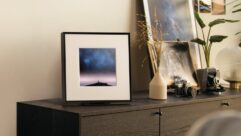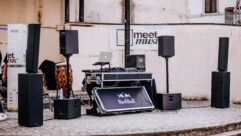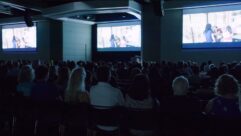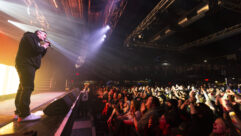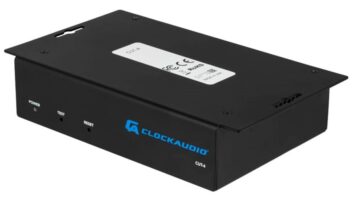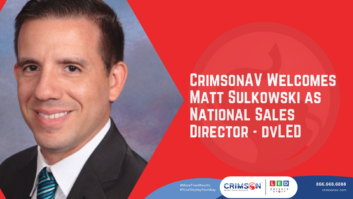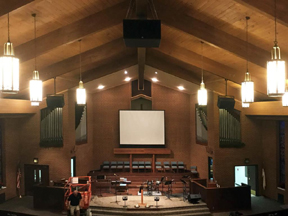
SVC Podcast – Show Notes – Show 159-1
In this edition of the SVC Podcast, SVC Contributing Editor Bennett Liles talks with Scott Oliver, president of Centerline Audio Visual Company in Hendersonville, Tennessee about the total sound system renovation done for the First Baptist Church of Manchester. The upgrade included Ashly nXp Series network multi-mode amplifiers with onboard Protea DSP and a Dante network card for each amp. Scott discusses matching the sound system design to the worship style of the church and he details their stage monitoring setup.
For Part 2
Links of interest:
- Centerline Audio Visual Company in Hendersonville, Tennessee
- Ashly nXp3.04 two and four-channel amplifiers
- The Allen & Heath ME-U Hub used in the in-ear stage monitoring system
Download Podcast Here:
https://s3.amazonaws.com/nb-svc/public/public/FBC_Manchester_Centerline_…
From Sound & Video Contractor Magazine, this is the SVC Podcast with Scott Oliver of Centerline Audio Visual Company. Show notes and equipment links for the podcast are on the web site of Sound & Video Contractor Magazine at svconline.com.
The same story is happening in churches everywhere. In an effort to modernize their services with live music, the First Baptist Church of Manchester, Tennessee had to have a complete sound system revamp and they called in Scott Oliver with Centerline Audio Visual Company. He’s going to tell us how they did it with Danley speakers, Ashly Amps and a Soundcraft Si Performer at front of house. That’s up next on the SVC Podcast.
Scott, glad to have you with us on the SVC Podcast from Centerline Audio Visual Company in Hendersonville, Tennessee. That’s right outside of Nashville, isn’t it?
Yes, that’s correct. Thank you again for having me. And yes, we’re just northeast of Nashville in the hometown of Johnny Cash.
And lots of audio stuff going on there I’m sure, being that close to Nashville.
Oh yes. It’s an audio-rich home studio-rich environment. [Timestamp: 1:21]
Sure is. Today we’re talking about a church environment. This was at the First Baptist Church of Manchester, Tennessee and you were there centrally involved in this.
Yes.
Does Centerline AV specialize in churches or do you handle other types of projects as well?
Well you know the lion’s share of our business is with churches, but we do everything from commercial facilities and schools. We recently did the National Corvette Museum in Bowling Green. We’re about to do the racetrack across the street from the museum. And we’ve done a few recording studio installations here and there, but primarily yes it would be churches. [Timestamp: 2:00]
Okay, and this seems to follow a fairly common scenario at a lot of churches these days. The First Baptist Church of Manchester was traditional for a long time and then they modernized their services and brought in live music and that required some big changes in their sound system. How big is this place? What’s the seating capacity of the sanctuary?
You could pack them in there. You could probably do about 800, something like that. Not a huge, huge place. [Timestamp: 2:25]
I saw one of the pictures in the press release and it looks like a hard ceiling, hard walls so how are the acoustics in the church? Is it carpeted?
Well we’ve got of course carpeting on the floor and then there’s fabric-covered padded pews, but yes there’s a lot of hard surfaces. Especially the walls, it’s all red brick, and then the ceiling it’s just the stained hardwood and then there’s actually some stained glass in there as well. So yes, there’s a lot of reflective surfaces. There is a little bit of drywall on the back wall, but it’s a very reflective, very reflective room. The only saving grace with the room as far as acoustics go would be the fact that it is a slight trapezoid and it’s a trapezoid both in the vertical and the horizontal so it gets taller as it goes from the stage to the back of the room and then it gets wider as it goes from the stage to the back of the room. So that does help some. [Timestamp: 3:19]
And I think they have some plans at some point to do some acoustical treatment. What do plan to do with that?
Yeah there is a plan to do that and yes we are going to have to do that. As with any type of room that has these materials we of course have a pretty large buildup of energy in the 400-500 Hz range. So we’re going to go into some two-inch and three-inch thick absorbers placed on offsets, about three-inch offsets off the walls. And based on the calculations and some of the Ease data that we obtained when we built the model to put the speakers in, we think that’s going to be adequate. I don’t think we’re going to have to do anything to the ceiling at all. [Timestamp: 4:01]
I would think that once you have that underway you might have to go through and tweak the settings on the sound system to sort of match the new acoustical environment.
Yeah. I mean there will be a small amount of tweaking. The main thing will be looking at the midrange and the low mid. That will be what we’re after. Obviously when we did the calibrations with the new system in the room as it is we did have to pull a little bit of low mid out of it. And hopefully we’ll be able to bring those back in once we get the acoustic treatments in there. [Timestamp: 4:31]
There’s usually one thing that stands out on a project like this as the biggest hurdle to get over. So what was the main challenge on the First Baptist Church of Manchester?
When we do a design we go through a full prediction process, you know trial and error with the speaker systems that we’re thinking about using and would like to use, but through the prediction process there’s always a lot more failures than there are successes. So that takes a fair amount of time, but I would say actually being on the job we really try and keep it simple. We don’t want a whole lot of unnecessary extra speaker elements in the room creating a whole bunch of negative destructive interference so we use as few speakers as possible. But the biggest challenge, believe it or not, was hanging the subwoofer because we had to move a lot of pews out of the way and unbolt them and that sort of thing and bring in a lift and get the sub up there. Other than that it didn’t cause a lot of grief getting the system installed. [Timestamp: 5:31]
That’s very prominent in the pictures I’ve seen. That’s a great place to have that with the reflective surfaces. I noticed you went with Ashly Audio amplifiers, the nXp Series amps on that.
Yes.
Do those have any remote control capabilities that you would use for this type of project?
We’re not really remoting into those. I mean there were several reasons that we picked Ashly. One of the biggest reasons is the support of Ashly. There’s a lot of amplifier companies out there that they make great products but the thing we like about Ashly is they have a huge product line and as a company they’re very supportive of us dealers. So we’re sort of hanging our hat on Ashlys for the most part. In some of the bigger churches where we’re doing Danley Jericho’s we’re using the Danley amplifier, but in the smaller ones like this we’re pretty much defaulting to Ashly. I just can’t find enough good things to say about those guys. It’s just a great company, a great product. If there’s ever a problem I mean it’s within 24 hours we have an advance replacement in our hands. And it’s great just to be able to dial a phone number and talk to one of the guys that designed the amps when we have questions. So no remote control capabilities on the amplifiers. We are using Dante, but aside from that they’re pretty much locked down from when we did the calibration. We don’t like people in there tweaking stuff without us knowing. [Timestamp: 6:56]
And especially since you are in a tech volunteer situation where your guys set everything up and I guess the emphasis would be on simplicity and ease of operation but at the same time they were bringing in live music with all that it involves.
Absolutely. Before I moved to Nashville in 2006 I lived in Los Angeles for 20 years. I spent 8-9 years working in a lot of mega churches down in Orange County, California; Saddleback, Mariners and South Coast. I was primarily a musician. I did do a little bit of front of house work, but we were doing the contemporary worship thing years before it came east, you know, east of the Mississippi. And now it’s very common to see what was once a traditional church maybe not necessarily completely converting but adding a contemporary service on Sunday morning. And obviously when you do that the needs of technology and acoustics, you know it really changes. It can become challenging trying to balance especially aesthetics if you’re doing contemporary worship in a traditional type room. You have to be careful with aesthetics. And then there’s other challenges acoustically, but yeah that’s very, very common now. [Timestamp: 8:13]
One of the trickier things to deal with on the live performances is probably how they do the stage monitoring.
Oh absolutely. We’re a firm believer in as far as stage monitors go the smallest footprint, the smallest driver possible. And if you’re going to use in-ears then that’s great too. Even at First Baptist Manchester they will actually use their Allen & Heath ME hub, the actual box itself – the control station – they’ll plug that into a powered wedge. And so they have a lot of flexibility there, but yeah we’re seeing a lot more of that as well. In-ear monitoring is becoming very, very common. But if it’s stage monitors, buy small ones, as small as you can get. [Timestamp: 8:52]
And then it’s balancing single voice intelligibility with live music without a big reconfiguration in between. Did you have to set up the Protea DSP for single voice and balancing music?
Well believe it or not we’re handling that way before we get to the DSP. It’s really funny. Today I just met with an architect on another church we’re doing and one of the things we discussed were the ALCONS of a room, which is the articulation loss of consonants. That is the root of intelligibility in a room. If you get the ALCONS correct, and we like to be way below 10 percent, but if you get your ALCONS right as far as the acoustics and the proper speakers in the proper positioning. Then when you go to the DSP really you’re just calibrating the speaker system overall to try to make it as flat as possible. I’ve got a lot of years in recording studios and part of my design philosophy is when I design systems be it audio, be it acoustics or whatever, a lot of people design with the idea that it’s a live music or a live sound environment. I actually design with the idea that it is a critical listening environment and what do you do in church? You boil it down to the lowest common denominator, you talk and you sing. Those are the two most important things. So we first design to make sure that articulation is the voice. That’s paramount. That comes before everything else. And then we treat the room acoustically depending on whether or not it’s a high energy church. We may not treat a typical Southern Baptist church the same way we would a rock and roll church. But we apply the acoustic treatments based on what they actually do in the room. But as far as the DSP goes I want the room sonically to behave like a big control room in a recording studio and so we like to get it as flat as possible. And we’ve found that as long as we’re paying attention to the ALCONS and the acoustics, the DSP, the only job it’s doing it just keeping it flat and if there’s delays or whatever, keeping those things properly in time. And that’s really about it. [Timestamp: 11:08]
Well, it sounds like you’ve laid a good foundation for them and they could have called a lot of people for that in the Nashville area. There’s lots of competition.
Oh yes.
In Part 2 we’ll get into the Soundcraft mixer and the Danley Speakers.
Okay.
It’s Scott Oliver, President of Centerline Audio Visual Company in Hendersonville, Tennessee and the total sound system change for the First Baptist Church of Manchester. Thanks, Scott for telling us about it.
Hey, thank you for having me.
It was great to have you here for the SVC Podcast with Scott Oliver. Show notes and equipment links are on the website of Sound & Video Contractor Magazine at svconline.com. Next week Scott will get into the Danley Speakers and the Soundcraft SI Performer Front of House mixer. That’s on the next SVC Podcast.


